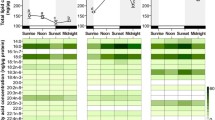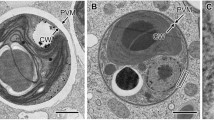Abstract
Intracellular lipid droplets (LDs) have been proposed to play a key role in the mutualistic endosymbiosis between reef-building corals and the dinoflagellate endosymbiont Symbiodinium spp. This study investigates and identifies LD proteins in Symbiodinium from Euphyllia glabrescens. Discontinuous Percoll gradient centrifugation was used to separate Symbiodinium cells from E. glabrescens tentacles. Furthermore, staining with a fluorescent probe, Nile red, indicated that lipids accumulated in that freshly isolated Symbiodinium cells and lipid analyses further showed polyunsaturated fatty acids (PUFA) was abundant. The stable LDs were purified from endosymbiotic Symbiodinium cells. The structural integrity of the Symbiodinium LDs was maintained via electronegative repulsion and steric hindrance possibly provided by their surface proteins. Protein extracts from the purified LDs revealed a major protein band with a molecular weight of 20 kDa, which was termed Symbiodinium lipid droplet protein (SLDP). Interestingly, immunological cross-recognition analysis revealed that SLDP was detected strongly by the anti-sesame and anti-cycad caleosin antibodies. It was suggested that the stable Symbiodinium LDs were sheltered by this unique structural protein and was suggested that SLDP might be homologous to caleosin to a certain extent.






Similar content being viewed by others
Abbreviations
- FSW:
-
Filtered natural seawater
- LD:
-
Lipid droplet
- MLDP:
-
Major lipid droplet protein
- PCR:
-
Polymerase chain reaction
- Q-TOF:
-
Quadrupole time-of-flight
- RFLP:
-
Restriction fragment length polymorphism
- SLDP:
-
Symbiodinium lipid droplet protein
- TAG:
-
Triacylglycerol
- PUFA:
-
Polyunsaturated fatty acid
References
Awai K, Matsuoka R, Shioi Y (2012) Lipid and fatty acid compositions of Symbiodinium strains. Proceedings of the 12th International Coral Reef Symposium
Battey JF, Patton JS (1984) A reevaluation of the role of glycerol in carbon translocation inzooxanthellae-coelenterate symbiosis. Mar Biol 79:27–38
Bligh EG, Dyer WJ (1959) A rapid method for total lipid extraction and purification. Can Physiol J Biochem Physiol 37:911–917
Chen JC, Tsai CC, Tzen JTC (1999) Cloning and secondary structure analysis of caleosin, a unique calcium-binding protein in oil bodies of plant seeds. Plant Cell Physiol 40:1079–1086
Chen WNU, Kang HJ, Weis V, Mayfield AB, Jiang PL, Fang LS, Chen CS (2012) Diel rhythmicity of lipid-body formation in a coral-Symbiodinium endosymbiosis. Coral Reefs 31:521–534
Cook CB, D’Elia CF (1987) Are natural populations of zooxanthellae ever nutrient-limited? Symbiosis 4:199–211
Davidi L, Katz A, Pick U (2012) Characterization of major lipid droplet proteins from Dunaliella. Planta 236:19–33
Franklin DJ, Guldberg OH, Jones RJ, Berges JA (2004) Cell death and degeneration in the symbiotic dinoflagellates of the coral Stylophora pistillata during bleaching. Mar Ecol Prog Ser 272:117–130
Fuchs B, Schiller J, Sub R, Schurenberg M (2007) A direct and simple method of coupling matrix-assisted laser desorption and ionization time-of-flight mass spectrometry (MALDI-TOF MS) to thin layer chromatography (TLC) for the analysis of phospholipids from egg yolk. Anal Bioanal Chem 389:827–834
Greenspan P, Mayer EP, Fowler SD (1985) Nile red—a selective fluorescent stain for intracellular lipid droplets. J Cell Biol 100:965–973
Guillard RRL (1975) In: Smith WL, Chanley MH (eds) Culture of marine invertebrate animals. Plenum Press, New York
Guillard RRL, Ryther JH (1962) Studies of marine planktonic diatoms. I. Cyclotella nana Hustedt and Detonula confervacea Cleve. Can J Microbiol 8:229–239
Herman EM (1987) Immunogold-localization and synthesis of an oil body membrane protein in developing soybean seeds. Planta 172:336–345
Jiang PL, Tzen JT (2010) Caleosin serves as the major structural protein as efficient as oleosin on the surface of seed oil bodies. Plant Signal Behav 5:447–449
Jiang PL, Pasaribu B, Chen CS (2014) Nitrogen-deprivation elevates lipid levels in Symbiodinium spp. by lipid droplet accumulation: morphological and compositional analyses. PLoS ONE 9:e87416
Kellogg RB, Patton JS (1983) Lipid droplets-medium of energy exchange in the symbiotic anemone Condylactis gigantea: a model coral polyp. Mar Biol 75:137–149
Laemmli UK (1970) Cleavage of structural proteins during the assembly of the head of bacteriophage T4. Nature 227:680–685
LaJeunesse TC (2004) Investigating the biodiversity, ecology, and phylogeny of endosymbiotic dinoflagellates in the genus Symbiodinium using the ITS region: in search of a species level marker. J Phycol 37:866–880
Leshevalier D, Bahl J, Moneger R (1972) Etude microanalytique des lipids dans de petits echantillons d’etioplastes et de chloroplasts isoles de feuilles de ble. CR Acad Sci Paris 275:963–966
Lin LJ, Tzen JTC (2004) Two distinct steroleosins are present in seed oil bodies. Plant Physiol Biochem 42:601–608
Lin LJ, Tai SSK, Peng CC, Tzen JTC (2002) Steroleosin, a sterol-binging dehydrogenase in seed oil bodies. Plant Physiol 128:1200–1211
Lin IP, Jiang PL, Chen CS, Tzen JTC (2012) A unique caleosin serving as the major integral protein in oil bodies isolated from Chlorella sp. cells cultured with limited nitrogen. Plant Physiol Biochem 61:80–87
Moellering ER, Benning C (2010) RNA interference silencing of a major lipid droplet protein affects lipid droplet size in Chlamydomonas reinhardtii. Eukaryot Cell 9:97–106
Murphy DJ (2001) Biogenesis and functions of lipid bodies in animals, plants and microorganisms. Prog Lipid Res 40:325–438
Muscatine L, McCloskey LR, Marian RE (1981) Estimating the daily contribution of carbon from zooxanthellae to coral animal respiration. Limnol Oceanogr 26:601–611
Muscatine L, Falkowski PG, Porter JW, Dubinsky Z (1984) Fate of photosynthetic fixed carbon in light- and shade-adapted colonies of the symbiotic coral Stylophora pistillata. Proc R Soc Lond B Biol Sci 222:181–202
Nguyen HM, Baudet M, Cuine S, Adriano JM, Barthe D, Billon E, Bruley C, Beisson F, Peltier G, Ferro M, Li-Beisson Y (2011) Proteomic profiling of oil bodies isolated from the unicellular green microalga Chlamydomonas reinhardtii: with focus on proteins involved in lipid metabolism. Proteomics 11:4266–4273
Oku H, Yamashiro H, Onaga K (2003) Lipid biosynthesis from [14C]-glucose in the coral Montipora digitata. Fish Sci 69:625–631
Pasaribu B, Lin IP, Chen CS, Lu CY, Jiang PL (2014) Nutrient limitation induced qualitative changes of fatty acid and caleosin expression in Auxenochlorella protothecoides. Biotechnol Lett 36:175–180
Patton JS, Burris JE (1983) Lipid synthesis and extrusion by freshly isolated zooxanthellae (symbiotic algae). Mar Biol 75:131–136
Peled E, Leu S, Zarka AZ, Weiss M, Pick U, Khozin-Goldberg I, Boussiba S (2011) Isolation of a novel oil globule protein from the green alga Haematococcus pluvialis (Chlorophyceae). Lipids 46:851–861
Peng CC, Tzen JTC (1998) Analysis of the three essential constituents of oil bodies in developing sesame seeds. Plant Cell Physiol 39:35–42
Peng SE, Wang YB, Wang LH, Chen WNU, Lu CY, Fang LS, Chen CS (2010) Proteomic analysis of symbiosome membranes in cnidaria dinoflagellate endosymbiosis. Proteomics 10:1002–1016
Peng SE, Chen WNU, Chen HK, Lu CY, Mayfield AB, Fang LS, Chen CS (2011) Lipid bodies in coral-dinoflagellate endosymbiosis: proteomic and ultrastructural studies. Proteomics 11:3540–3555
Peng SE, Chen CS, Song YF, Huang HT, Jiang PL, Chen WNU, Fang LS, Lee YC (2012) Assessment of metabolic modulation in free-living versus endosymbiotic Symbiodinium using synchrotron radiation-based infrared microspectroscopy. Biol Lett 23:434–437
Qu R, Wang SM, Lin YH, Vance VB, Huang AHC (1986) Characteristics and biosynthesis of membrane proteins of lipid bodies in the scutella of maize (Zea mays L.). Biochem J 234:57–65
Rowan R, Knowlton N (1995) Intraspecific diversity and ecological zonation in coral-algal symbiosis. Proc Natl Acad Sci 7:2850–2853
Rowan R, Powers DA (1991) A molecular genetic classification of zooxanthellae and the evolution of animal-algal symbiosis. Science 251:1348–1351
Rowan R, Whitney SM, Fowler A, Yellowlees D (1996) Rubisco in marine symbiotic dinoflagellates: form I1 enzymes in eukaryotic oxygenic phototrophs encodied by a nuclear multigene family. Plant Cell 8:539–553
Stat M, Carter D, Hoegh-Guldberg O (2006) The evolutionary history of Symbiodinium and scleractinian host-Symbiosis, diversity, and the effect of climate change. Persp Plant Ecol Evol Syst 8:23–43
Stochaj WR, Grossman AR (1997) Differences in the protein profiles of cultured and endosymbiotic Symbiodinium sp. (Pyrrophyta) from the anemone Aiptasia pallid (Anthozoa). J Phycol 33:44–53
Tai SSK, Chen MCM, Peng CC, Tzen JTC (2002) Gene family of oleosin isoforms and their structural stabilization in sesame seed oil bodies. Biosci Biotechnol Biochem 66:2146–2153
Tzen JTC, Lie GC, Huang AHC (1992) Characterization of the charged components and their topology on the surface of plant seed oil bodies. J Biol Chem 267:15626–15634
Tzen JTC, Cao YZ, Laurent P, Ratnayake C, Huang AHC (1993) Lipids, proteins, and structure of seed oil bodies from diverse species. Plant Physiol 101:267–276
Tzen JTC, Peng CC, Cheng DJ, Chen ECF, Chiu JMH (1997) A new method for seed oil body purification and examination of oil body integrity following germination. J Biochem 121:762–768
Tzen JTC, Wang MMC, Chen JCF, Lin LJ, Chen MCM (2003) Seed oil body proteins: oleosin, caleosin, and steroleosin. Curr Topics Biochem Res 5:133–139
Yang SY, Keshavmurthy S, Obura D, Sheppard CRC, Visram S, Chen CA (2012) Diversity and distribution of Symbiodinium associated with seven common coral species in the chagos archipelago, central Indian ocean. PLoS ONE 7:e35836
Zhu C, Lee Y, Chao T (1997) Effects of temperature and growth phase on lipid and biochemical composition of Isochrysis galbana tk1. J Appl Phycol 9:451–457
Acknowledgments
The work was supported by a grant from the National Science Council, Taiwan, ROC (NSC 102-2313-B-291-001 to PL Jiang).
Author information
Authors and Affiliations
Corresponding authors
Electronic Supplementary Material
Below is the link to the electronic supplementary material.
Fig. S1
Symbiodinium clade identification by Restriction Fragmentation Length Polymorphism (RFLP). The clade of the Symbiodinium cells was identified by RFLP analysis of the n18S-rDNA. The fragments of n18S-rDNA were digested by TaqI and Sau3AI and then resolved by electrophoresis. The RFLP patterns of the freshly isolated and free-living culture Symbiodinium cells were similar to each other. Both were identified as belonging to clade C. (GIF 204 kb)
Rights and permissions
About this article
Cite this article
Pasaribu, B., Lin, IP., Tzen, J.T.C. et al. SLDP: a Novel Protein Related to Caleosin Is Associated with the Endosymbiotic Symbiodinium Lipid Droplets from Euphyllia glabrescens . Mar Biotechnol 16, 560–571 (2014). https://doi.org/10.1007/s10126-014-9574-z
Received:
Accepted:
Published:
Issue Date:
DOI: https://doi.org/10.1007/s10126-014-9574-z




